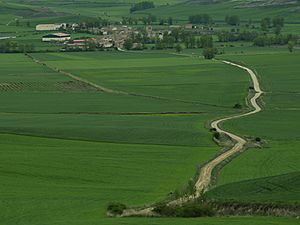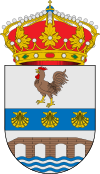Hornillos del Camino facts for kids
Quick facts for kids
Hornillos del Camino
|
||
|---|---|---|

View of Hornillos del Camino from Matamulos
|
||
|
||
| Country | Spain | |
| Autonomous community | ||
| Province | ||
| Comarca | Odra-Pisuerga | |
| Area | ||
| • Total | 14 km2 (5 sq mi) | |
| Elevation | 825 m (2,707 ft) | |
| Population
(2018)
|
||
| • Total | 58 | |
| • Density | 4.14/km2 (10.7/sq mi) | |
| Time zone | UTC+1 (CET) | |
| • Summer (DST) | UTC+2 (CEST) | |
| Postal code |
09230
|
|
| Website | http://www.hornillosdelcamino.es/ | |
Hornillos del Camino is a small town in the province of Burgos, located in the region of Castile and León, Spain. In 2018, about 58 people lived here. This makes it a very quiet and peaceful place.
The town is especially known because it sits right on the French Way, which is the most popular part of the Way of St. James. This ancient route is famous for pilgrims who walk to Santiago de Compostela.
Contents
Hornillos del Camino: A Small Spanish Town
Hornillos del Camino is a charming municipality in northern Spain. It covers an area of about 14 square kilometers. The town is located at an elevation of 825 meters above sea level. This means it's quite high up, offering nice views of the surrounding countryside.
The name "Hornillos" might come from the word for "small ovens." This could refer to old kilns used for making bricks or pottery. "Del Camino" means "of the Way," clearly showing its connection to the famous pilgrimage route.
Life in Hornillos
Life in Hornillos del Camino is calm and traditional. The town's small size means everyone knows each other. Many of the buildings are old and made of stone. They show the history of the area.
The local economy often relies on farming and tourism. The pilgrims passing through bring business to the town. They might stay in hostels or eat at local restaurants.
The Way of St. James: A Historic Path
The Way of St. James (known as Camino de Santiago in Spanish) is a network of ancient pilgrim routes. These routes all lead to the Cathedral of Santiago de Compostela in Galicia, northwestern Spain. Here, people believe the remains of Saint James the Great are buried.
Pilgrims have walked these paths for over a thousand years. They come from all over Europe and beyond. The journey is a spiritual one for many. For others, it's a chance to explore history, nature, and meet new people.
The French Way: Hornillos' Connection
Hornillos del Camino is an important stop on the French Way (Camino Francés). This is the most famous and well-traveled route of the Way of St. James. It starts in Saint-Jean-Pied-de-Port in France and crosses the Pyrenees mountains into Spain.
As pilgrims walk west across Spain, Hornillos del Camino offers a place to rest. It's a typical village along the route, providing essential services. These include places to sleep, eat, and sometimes even a church for reflection.
Why is the French Way so Popular?
The French Way is popular for several reasons:
- History: It has been used for centuries, making it rich in historical sites.
- Infrastructure: It has many hostels (called albergues) and services for pilgrims.
- Scenery: The route passes through diverse landscapes, from mountains to plains.
- Community: Many pilgrims walk this route, creating a strong sense of community.
History of Hornillos del Camino
The history of Hornillos del Camino is closely tied to the Way of St. James. Towns along the Camino often grew because of the pilgrims. They needed places to stay and food to eat.
During the Middle Ages, the pilgrimage to Santiago de Compostela was very important. Many hospitals and churches were built along the route. These helped pilgrims on their long journey. Hornillos would have been one of these vital stops.
Medieval Life and the Camino
In medieval times, Hornillos would have been a bustling place. Pilgrims from different countries would pass through. This brought new ideas and goods to the town. The local people would have provided services like:
- Shelter in inns or monasteries.
- Food and water.
- Medical care for tired or sick travelers.
The town's location on the Camino helped it to grow and survive. It was a place where travelers could feel safe and find help.
Geography and Surroundings
Hornillos del Camino is located in a region known for its flat plains. These plains are part of the larger Meseta Central of Spain. The landscape around Hornillos is mostly agricultural. You will see fields of wheat and other crops.
The climate here is continental. This means it has cold winters and hot, dry summers. Spring and autumn are milder, making them popular times for pilgrims to walk the Camino.
Natural Features
While the area is mostly flat, there are small hills and valleys. These add variety to the landscape. The vegetation is typical of dry plains, with some trees along rivers or streams.
The quiet countryside offers a peaceful environment. It's a stark contrast to busy cities. This makes it a perfect place for those seeking a break from modern life.
Local Culture and Traditions
Like many small Spanish towns, Hornillos del Camino has its own local traditions. These often revolve around religious festivals and community gatherings. The presence of the Camino also influences local culture.
Pilgrims often share their stories and traditions with the locals. This creates a unique blend of cultures in towns along the route. The hospitality shown to pilgrims is a key part of the local identity.
Festivals and Events
Small towns like Hornillos often celebrate their patron saints. These festivals usually involve:
- Religious processions.
- Traditional music and dancing.
- Community meals.
These events are a great way to experience the authentic culture of the region. They bring the whole community together.
See also
 In Spanish: Hornillos del Camino para niños
In Spanish: Hornillos del Camino para niños


